DevOps vs. Agile: Everything You Need to Know
Quick Summary: Devops vs Agile, this is one of hottest topic of debate among the developers. Both methodologies has something to offer. Some find out DevOps to be the best one and some consider Agile. If this is the case with you, don’t worry as in this article we will help you to understand about Agile and DevOps in detail with all the differences and similarities!
Introduction
We are in a generation where technological advancements are so high that one sometimes gets confused about which one to adopt. The same condition arises when one has to choose between Agile and DevOps methodologies. There is a chance you too might have been stuck at the same point with DevOps vs Agile. If this happened, don’t worry!
Primarily it is important to get a brief overview of both. Well, DevOps and Agile are two methodologies that have revolutionized the software development industry. While both aim to improve efficiency and collaboration within development teams, they have distinct approaches and objectives. In this article, we will explore Agile vs DevOps The Difference, as well as their individual benefits and challenges.
By understanding these methodologies, you will gain valuable insights into how they can be implemented in your organization, and ultimately helping you make informed decisions to optimize your software development process. Keep on reading till the end so that you will be able to know about both these methodologies in detail. Let’s have a look!
DevOps Statistics to know:
As per research the adoption of DevOps is kept on increasing. There are so many spheres in the companies that are focusing on adapting agile methodologies. These are as follows:-
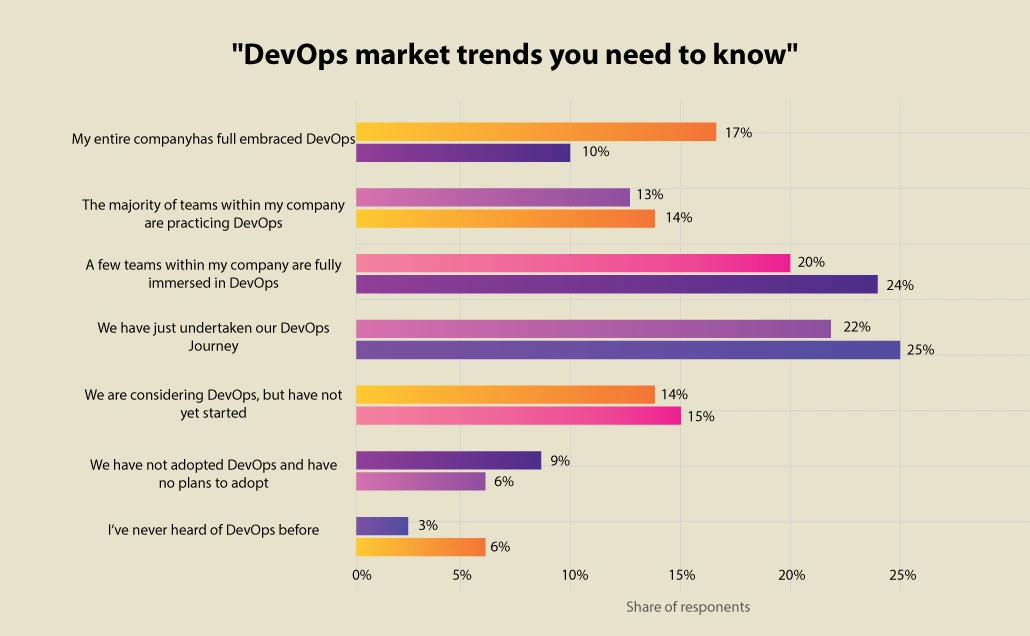
About DevOps
DevOps, short for Development and Operations, is like a super-powered team that brings together software developers and IT professionals to create and deliver amazing software products. It’s all about breaking down barriers and fostering collaboration between these two essential groups.
In the past, developers would build software and then hand it off to operations to deploy and maintain. But this often led to headaches. Developers would say, “It works on my computer!” while operations would struggle to make it run smoothly in the real world. That’s not a great situation, right?
With DevOps, everyone works together from the beginning. Developers and operations teams join forces to design, build, test, and release software as a unified force. They share knowledge, tools, and responsibilities to ensure that the software is not only functional but also reliable, scalable, and secure.
If there is any additional input needed, then also the DevOps Consulting Services team of DevOps engineer, can collaborate and discuss what they need to bring to the table.
Features of DevOps
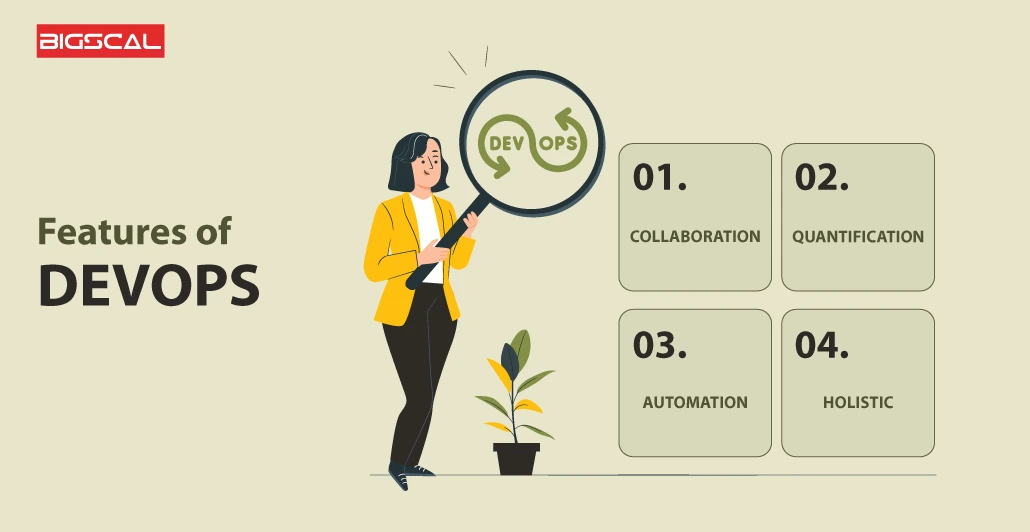
The major features that are making DevOps a better choice are as follows:
Collaboration
One of the coolest things about DevOps is its focus on collaboration. It encourages developers, operations personnel, and other stakeholders to work closely together throughout the software development lifecycle. Through this developers will be able to become part of effective communication and teamwork. Furthermore, it breaks down silos and encourages everyone to share their knowledge and expertise. This collaboration leads to faster feedback loops, better decision-making, and ultimately, the delivery of high-quality software.
Quantification
DevOps is all about measuring and quantifying things. It majorly focuses on the use of metrics and data to evaluate performance, identify bottlenecks, and make informed decisions. This also majorly keeps track of key indicators like code quality, deployment frequency, and customer satisfaction. As a result, it allows the teams to gain valuable insights into their processes. These metrics enable continuous improvement, allowing teams to spot areas for optimization and implement changes that lead to better outcomes.
Automation
Among all the features, the automation one is the most considerable one. It goals to automate repetitive and manual tasks as lots as viable, liberating up precious time and decreasing the possibilities of human error. There are some automation tools and frameworks as properly that help in streamlining processes like constructing, checking out, and deploying software. With the assist of automating these duties, DevOps groups can supply software faster, extra reliably, and with greater consistency.
Holistic
DevOps takes a holistic method to software program development and delivery. It considers the whole software program lifecycle, from planning and coding to deployment and renovation. By treating software development as a non-stop and interconnected method, DevOps ensures that each segment receives the attention it merits. This approach helps teams identify and address issues early on, resulting in higher collaboration, smoother deployments, and quicker time to market.
Advantages of Using DevOps
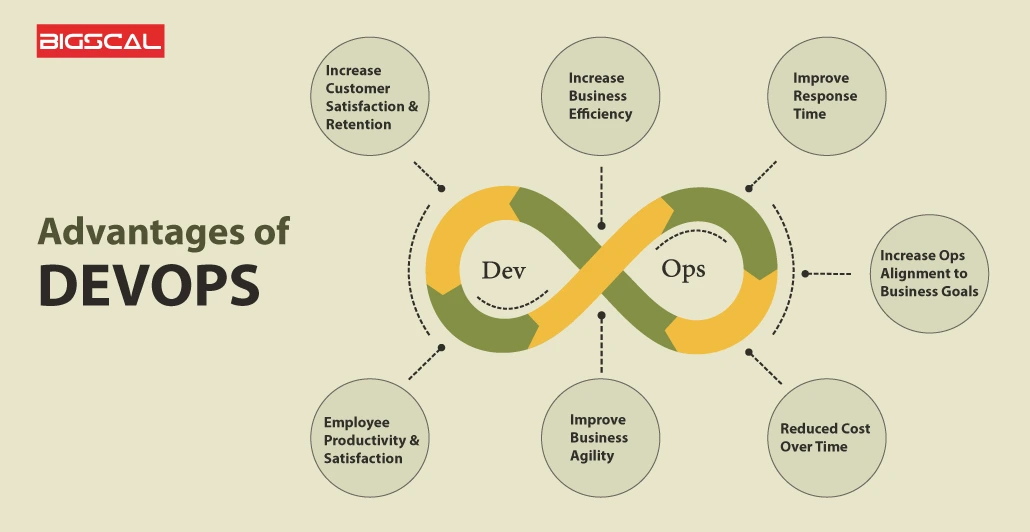
In this section, we will help you to know about the advantages of using DevOps in detail. The major advantages are as follows:
Increase Customer Satisfaction & Retention
DevOps focuses on delivering value to customers by continuously improving and enhancing software applications. By adopting DevOps practices, organizations can release new features and updates more frequently, leading to faster response times to customer needs and preferences. This increased agility and responsiveness contribute to higher customer satisfaction and improved retention rates.
When new features are available to use by people, they will be able to retain more of the existing application and would love using it too. Also, it allows customers to have their hands on new features that they may get through some other apps.
Increase Business Efficiency
DevOps promotes automation and streamlining of processes, enabling organizations to achieve higher levels of efficiency. It engages in automating repetitive tasks such as code testing, deployment, and infrastructure provisioning, teams can reduce manual errors, save time, and increase productivity. This efficiency translates into faster software delivery, reduced time to market, and improved resource utilization, ultimately benefiting the overall business operations. When the overall businesses get benefitted, it results in benefiting the overall growth of the business as well.
Improve Response Time
In a DevOps surroundings, groups collaborate closely and observe agile methodologies, enabling quicker identification and backbone of troubles. By integrating development, operations, and first-rate assurance capabilities, companies can boost up the software improvement lifecycle. Quick detection and backbone of insects, protection vulnerabilities, or overall performance troubles lead to stepped forward response times, minimizing disruptions, and improving purchaser stories.
Increase Ops Alignment to Business Goals
DevOps promotes better alignment between operations teams and commercial enterprise goals. By breaking down silos and fostering collaboration among distinctive departments, corporations can make certain that operations teams have a clean knowledge of business targets. This alignment allows operations teams to prioritize and recognition on sports that without delay make a contribution to reaching business dreams, main to progressed universal performance and outcomes.
Reduced Cost over Time
While imposing DevOps practices requires initial funding and attempt, it in the long run leads to price savings ultimately. By automating guide strategies and disposing of bottlenecks, organizations can reduce the variety of sources required for software program improvement and deployment. Furthermore, the early detection and resolution of troubles prevent expensive downtime and reduce the want for highly-priced firefighting efforts. These factors combined bring about reduced operational fees and stepped forward financial performance.
Improve Business Agility
DevOps is characterised by using its emphasis on continuous integration, delivery, and deployment. By breaking down large software program releases into smaller, practicable increments, companies can quick respond to converting market needs and commercial enterprise desires. The potential to supply software updates hastily and reliably permits corporations to evolve to evolving patron necessities, capture new opportunities, and live beforehand of the competition.
Employee Productivity & Satisfaction
The Role Of DevOp promotes collaboration, communication, and knowledge sharing amongst team individuals. By adopting a culture of collaboration and using equipment that facilitate teamwork, companies can enhance worker productivity and task pride. DevOps practices additionally empower group members to take possession and obligation for their paintings, leading to better stages of engagement, creativity, and common process pride.
About Agile
After understanding about DevOps, this is the time which will learn about Agile. Agile is a challenge control and software program development technique that emphasizes flexibility, collaboration, and iterative development. It is a fixed of values and concepts that guide the improvement method, enabling teams to reply speedy to trade and supply fantastic consequences.
The Agile method originated inside the software improvement enterprise in the early 2000s as a response to the limitations of traditional, linear assignment control methods. It became a innovative shift from the traditional waterfall model, where necessities were constant at the beginning, and modifications were hard to deal with later within the method.
Also, it promotes adaptive making plans, evolutionary development, early transport, and non-stop improvement. The core standards of agile are mentioned in the Agile Manifesto, a record created by way of a group of software program developers in search of an extra bendy and collaborative method to software development.
Agile statistics to know about:
The adoption of Agile throughout the market is worth noticing, As per the research done, the current market trends are as follows:
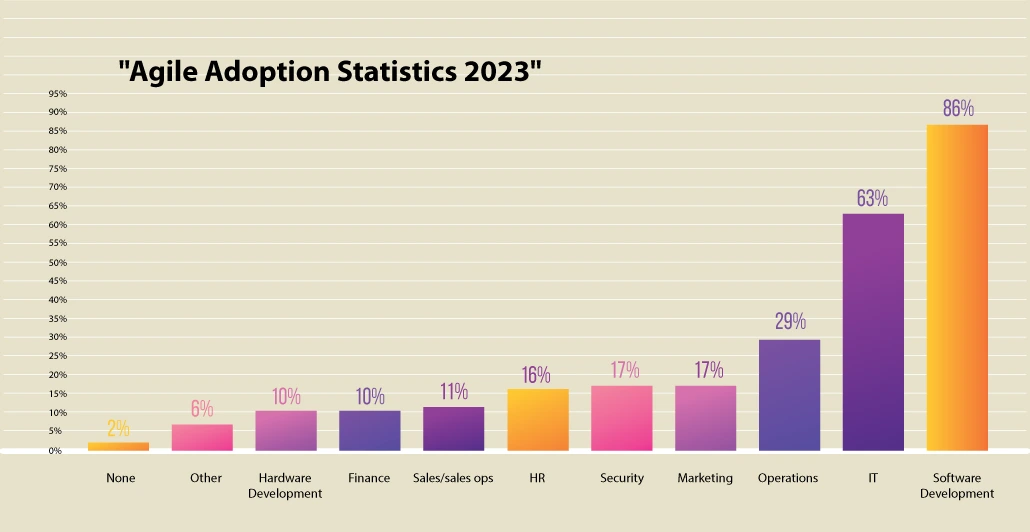
Features of Agile
The features of agile that are a must to know before reaching Agile software developers are as follows:
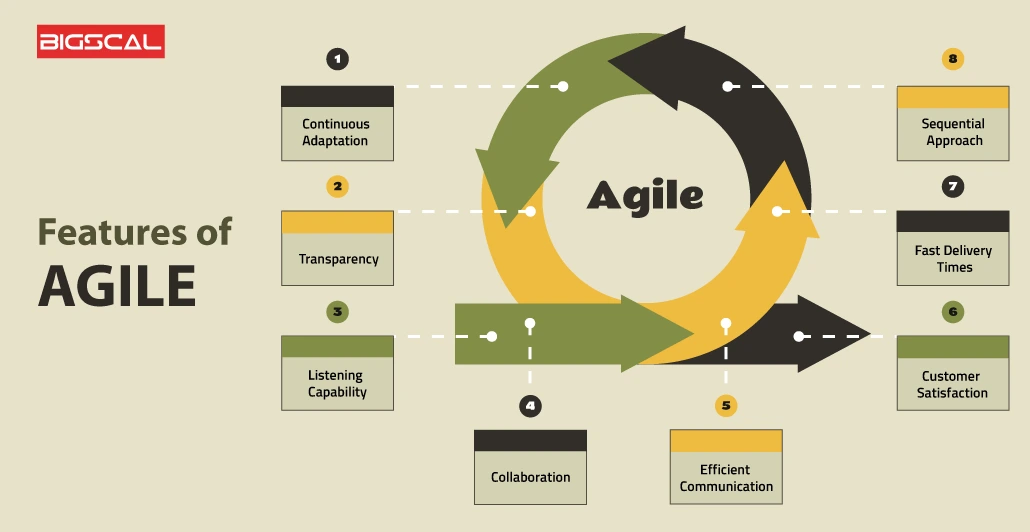
-
- Continuous Adaptation
Agile methodology is characterized by its ability to adapt and respond to changing circumstances. It recognizes that requirements and priorities can evolve throughout a project’s lifecycle. Agile teams embrace change and regularly reassess their goals and processes to ensure they align with the current needs of the project. By embracing continuous adaptation, Agile enables teams to be flexible and responsive, leading to better outcomes.
-
- Transparency
Agile promotes transparency at all levels of the project. Team members openly share information about progress, challenges, and decisions. This transparency ensures that everyone involved has visibility into the project’s status, enabling better collaboration and decision-making. Agile teams often use visual tools like task boards or burndown charts to provide clear and up-to-date information to all stakeholders.
-
- Listening Capability
Agile emphasizes active listening and encourages team members to genuinely understand each other’s perspectives. This fosters an environment where all voices are heard and respected. Agile teams actively seek feedback from customers, stakeholders, and team members, valuing their input in shaping the project’s direction. By actively listening, Agile teams can identify and address issues early, leading to improved project outcomes.
-
- Collaboration
Collaboration lies on the heart of Agile methodology. Agile teams paintings closely together, breaking down silos and inspiring pass-purposeful collaboration. They emphasize the cost of collective intelligence, bringing together various competencies and understanding to remedy problems and make informed selections. Collaborative practices along with daily stand-up conferences, frequent verbal exchange, and shared possession of duties decorate teamwork and enable faster development.
-
- Efficient Communication
Agile locations a sturdy emphasis on powerful and efficient communication. It promotes ordinary and well timed interactions among group individuals, stakeholders, and clients. Agile teams use diverse communication channels which includes face-to-face meetings, video conferences, and on line collaboration gear to ensure every person remains informed and aligned.
-
- Customer Satisfaction
Agile methodologies prioritize customer satisfaction as a core principle. By involving customers early and continuously seeking their feedback, Agile teams ensure that the final product meets their expectations. Agile practices such as iterative development and frequent product demonstrations allow customers to provide feedback throughout the project. This customer-centric approach results in higher-quality deliverables that align with the customers’ needs, ultimately leading to greater satisfaction.
-
- Fast Delivery Times
Agile methodologies emphasize delivering value quickly and iteratively. Instead of waiting for a complete and final product, Agile teams focus on delivering smaller increments of functionality, known as iterations or sprints. This iterative approach enables stakeholders to see progress sooner and provides opportunities for early validation and course correction. Fast delivery times allow Agile teams to respond to changing market conditions, gather feedback, and make improvements in a timely manner. There will be no delay in adapting the changes and people will be able to get their hands on the best features rapidly.
-
- Sequential Approach
Agile follows a sequential approach to project execution, typically in the form of iterative cycles. Each iteration involves a set of planned activities, such as requirements gathering, development, testing, and feedback. At the end of each iteration, the Agile Consulting Services team reflects on the results, adjusts their approach if needed, and plans the next iteration. This sequential approach helps break down complex projects into manageable and measurable chunks, ensuring a steady and controlled pace of work.
Benefits of Using the Agile Methodology
There are so many advantages that are available that make agile a choice for them. These are as follows:

-
- Increased visibility:
Agile methodologies, such as Scrum, Kanban, and Lean, provide increased visibility into the project’s progress. Through techniques like daily stand-up meetings, task boards, and burndown charts, team members have a clear view of the project status, including completed tasks, work in progress, and upcoming activities. This transparency enables better collaboration and allows stakeholders to track the project’s trajectory, making it easier to identify and address any issues or bottlenecks promptly.
-
- Increased adaptability (agility):
Agile approaches emphasize adaptability and flexibility in response to changing requirements, market conditions, or customer feedback. With short iterations called sprints, Agile enables teams to regularly reassess priorities, refine project goals, and adjust the course of action as needed. This iterative process allows for continuous improvement and ensures that the project remains aligned with business objectives, resulting in a more responsive and adaptable development process.
-
- Increased alignment:
Agile frameworks foster better alignment between the development team, stakeholders, and the overall business goals. Frequent communication and collaboration facilitate a shared understanding of project requirements and priorities. By involving stakeholders throughout the development cycle and incorporating their feedback, Agile ensures that the end product meets their expectations and aligns with their needs. This alignment minimizes the risk of developing a product that doesn’t deliver the intended value.
-
- Increased product quality:
Agile methodologies promote a strong focus on quality throughout the development process. By breaking the project into smaller, manageable tasks, Agile Consultancy Services teams can allocate sufficient time and resources to each task, ensuring attention to detail and quality assurance. Frequent testing, continuous integration, and early feedback from stakeholders enable the team to identify and address issues promptly, resulting in a higher-quality end product.
-
- Increased business value:
Agile methodologies prioritize delivering incremental value to the business at each iteration. By breaking the project into smaller, manageable features, the team can release functioning increments of the product earlier, enabling early user feedback and potential revenue generation. This incremental delivery approach allows businesses to capture value sooner, adapt their strategies based on user feedback, and make informed decisions about the future direction of the product.
-
- Increased customer satisfaction:
Agile methodologies place a strong emphasis on customer collaboration and involvement throughout the development process. Regular feedback loops, demos, and user testing enable customers to provide input and influence the product’s direction. This customer-centric approach ensures that the end product meets their needs and expectations, resulting in higher customer satisfaction. By delivering value early and continuously iterating based on customer feedback, Agile helps build stronger relationships with customers and fosters their loyalty.
-
- Decreased risk:
Agile methodologies mitigate project risks through their iterative and incremental nature. By breaking the project into smaller iterations, teams can identify and address potential issues early on, reducing the overall project risk. Frequent testing and feedback loops help uncover and resolve problems sooner, preventing them from escalating into larger issues later in the development cycle. Additionally, Agile’s adaptive nature allows teams to respond quickly to changing market conditions, reducing the risk of delivering an outdated or irrelevant product.
DevOps vs Agile: Differences Head to Head Comparison
In this section, we will help you to know about the differences between DevOps and Agile in Detail. These are as follows:
Purpose
DevOps is in consideration to manage end-to-end engineering processes. On the other end, Agile is helpful in managing complex projects.
Task in consideration
DevOps is in use for constant testing and delivery. On the other hand, the major focus of Agile is on constant changes happening.
Implementation
The major agenda behind using DevOps is to focus more on collaboration. So, it doesn’t link with any particular framework. On the other hand, Agile can be considered with multiple frameworks like Sprint, safe, and Scrum.
Skillset of the team
The Skillset of the team is also an integral factor in the lookout. In the case of DevOps, the skillset is divided into development and operations teams. On the other hand, in the case of Agile, the focus is on all the members who are a part of the team. This is so to let them have a wider skillset and to prepare them for the projects as well.
Team Size
Exploring the team size, DevOps has a larger team with so many people who are focusing on the core tasks of the project. On the other hand, agile relatively small teams. There are very few people who are engaged in it and they faster move ahead with the project completion.
Feedback
In the case of DevOps, the feedback is given by the internal teams. They are the ones who focus on the core tasks of the projects and bring out the best for the users. On the other hand, in the case of Agile, the feedback is given by the customers and the changes in the project can be done according.
Cross-functioning
With DevOps, communication is quite complex as the operational and developmental teams are separate from each other. On the other hand, with Agile, communication takes place effectively as every individual is engaged in some kind of project and cross-functioning can happen accordingly.
Comparison chart between Agile and Devops
After a detailed overview regarding differences, here we are presenting a chart that can help you to know more about it. These are as follows:
| Parameters | Agile | DevOps |
| Priorities | The focus of the agile approach is ongoing change. | The DevOps approach focuses on continuous testing and delivery. |
| Team size | Agile’s core team size is small. | Because it comprises all the stakeholders, the team size is rather large. |
| Scope | Agile helps manage challenging tasks. | The core principle of DevOps is to manage whole engineering processes. |
| Execution | Scrum, sprint, and safe are a few tactical frameworks that may be used to implement agile methodology. | Since DevOps focuses on cooperation, there is no widely accepted structure for it. |
| Team skill set | Training to develop a wide variety of equal and comparable skill levels among all team members. | Divides and distributes the skill set between the operating and development teams. |
| Duration | The process of agile development is divided into “sprints.” | With maximum releases, DevOps aims to meet benchmarks and schedules while delivering code to production every day or every few hours. |
| Feedback | The client gives the Feedback. | Internal staff is responsible for giving feedback. |
| Emphasis | Concentrates on techniques for creating and designing software. The agile team won’t care what happens to the programme once it is published. | Simply said, DevOps involves taking software products that are ready for release and delivering them in a reliable and secure way. |
| Goal/ Objective | It closes the gap between development and QA teams and client requirements. | It fills the gap between testing, development, and operations. |
| Communication | A widely popular approach for carrying out Agile software development is scrum. Daily scrum meetings are held. | Specifications and design papers are both a part of devops communications. To successfully manage the deployment process, the operational team must fully know the software launch and its network/hardware ramifications. |
| Challenges | Teams must be more productive, which is difficult to match every time. | Need environments for development, testing, and production to organize work. |
| Quality | Agile creates flawless app suites with the necessary components. As long as the changes were made on time during the project’s duration, they can be accepted with ease. | DevOps helps to provide high quality along with automation and quicker problem eradication. To manage quality standards, developers must adhere to architectural and coding best practises. |
Reach Bigscal if you wish to avail DevOps or Agile services for your project!
When it is about availing the services for your web development project, it is essential that you are getting in touch with the best software development service provider. Well, do not worry when we are here for you. At Bigscal, we believe in offering the best services at affordable prices. We are having a team of developers who will focus on everything from starting to the end of your project. From suggesting to you the type of methodology best suited for your project to convert it into reality, we will be there with you at every step. You just need to let us know and the rest will be our duty.
Our team of developers will be going to cater to your needs and will present your idea as a reality. But make sure to give us a clear idea about your project so that we will help you throughout. Also, after the project’s completion as well we will be always available to help you out with the project. We offer support and maintenance agile and devops development services as well. This will be helpful for us in long-term collaboration with our customers. So yes, it is right to say we will be your one-stop destination for all your project needs!
Conclusion
In conclusion, DevOps and Agile are two powerful methodologies that have reshaped the software development landscape. Here we have discussed key differences between DevOps and Agile methodologies for better understanding. DevOps emphasizes seamless collaboration and integration between development and operations teams, enabling faster delivery of high-quality software. Agile, on the other hand, prioritizes iterative development, customer feedback, and adaptability, ensuring that software aligns with evolving business needs.
While DevOps and Agile have unique characteristics, they share a common goal: to improve efficiency, productivity, and customer satisfaction. By combining the principles and practices of both methodologies, organizations can create a holistic approach to software development, leveraging the strengths of each.
Ultimately, the choice between DevOps and Agile depends on the specific needs and objectives of your organization. It is important to evaluate your team’s capabilities, project requirements, and organizational culture to determine the most suitable methodology. Whether you decide to embrace DevOps, Agile, or a hybrid approach, the key is to foster a culture of collaboration, continuous improvement, and adaptability in order to stay competitive in today’s rapidly evolving technological landscape. Reach the best DevOps or agile development company in order to avail the services!
FAQ
What is the difference between DevOps and Agile?
DevOps and Agile are two distinct methodologies that focus on different aspects of software development. Agile is a software development framework that emphasizes iterative development, collaboration, and flexibility. It breaks down projects into smaller, manageable tasks and promotes continuous feedback and adaptation.
On the other hand, DevOps is a set of practices that combines software development (Dev) and IT operations (Ops). It aims to streamline the software development lifecycle by promoting collaboration, automation, and continuous integration and delivery.
How do DevOps and Agile work together?
DevOps and Agile methodologies can complement each other to enhance the software development process. Agile focuses on iterative development and continuous feedback, allowing teams to respond to changing requirements quickly.
DevOps, on the other hand, ensures that the software can be deployed reliably and efficiently. By combining the two, organizations can achieve a faster and more efficient development cycle, with improved collaboration between development, operations, and other stakeholders.
What are the key characteristics of Agile?
Agile methodologies have several characteristics, including increased adaptability to changing requirements, improved collaboration and communication between teams, faster delivery of working software, and enhanced customer satisfaction. Agile promotes a flexible and iterative approach, enabling teams to respond to feedback and make adjustments throughout the development process. This leads to higher-quality software and a higher likelihood of meeting customer expectations.
What are the key characteristics of DevOps?
DevOps practices bring several characteristics to software development and operations. Key characteristics include increased speed and efficiency of software delivery through automation and continuous integration and delivery, improved collaboration between development and operations teams, enhanced reliability and stability of software systems through rigorous testing and monitoring, faster resolution of issues, and reduced time to recovery in case of failures.
DevOps helps bridge the gap between development and operations, resulting in smoother deployments and more reliable software.
Can an organization adopt DevOps without implementing Agile or vice versa?
Yes, it is possible for an organization to adopt DevOps without implementing Agile, and vice versa. While DevOps and Agile methodologies can work together synergistically, they can also be implemented independently to some extent. Organizations may prioritize one over the other based on their specific needs and goals.
However, it is important to note that combining both methodologies can often lead to better outcomes, as they address different aspects of the software development lifecycle and promote collaboration and continuous improvement.








